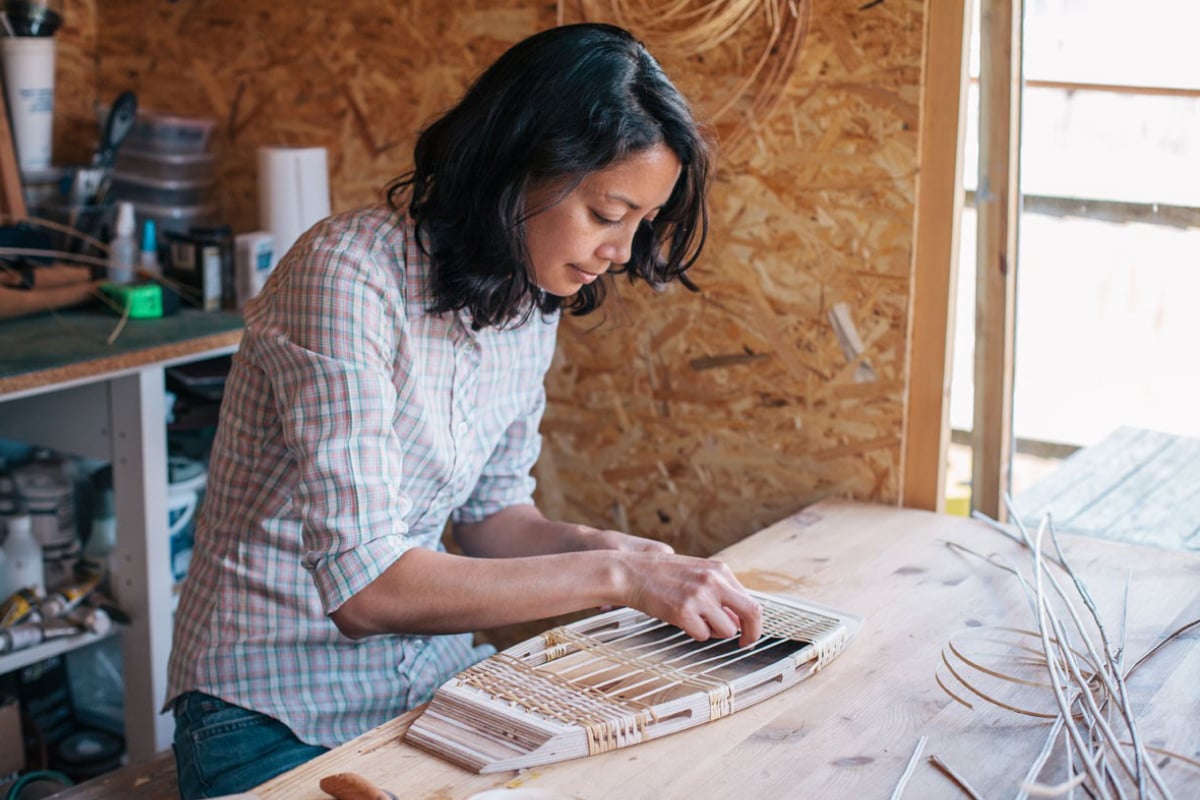
Monica Cass at work as a chair seater
Photo: Katherine Mager
Safeguarding heritage craft skills for the future
Are the UK's traditional craft skills in danger? Mary Lewis explains what’s being done to safeguard and celebrate heritage crafts as a vital but often overlooked part of British culture.
The best violins in the world are reputed to come from Cremona in Italy and have been acknowledged by UNESCO as part of the world’s shared heritage of craft skills and knowledge. Similarly, Croatia is renowned for its beautiful and intricate lacemaking tradition, which has been included on international UNESCO lists of intangible cultural heritage.
In the UK we have heritage crafts which are just as significant but, unlike our great monuments, we can’t nominate our traditional crafts to UNESCO because the UK is one of only 12 of 193 member states that has not yet ratified that convention.
Heritage Crafts is currently the only UK-based UNESCO-accredited NGO working primarily in the domain of traditional craftsmanship. It’s our mission to ensure craft skills are properly recognised for the contribution they make to the UK’s cultural heritage.
Our Red List of Endangered Crafts, first published in 2017, was the first report of its kind to rank traditional crafts by the likelihood they would survive to the next generation, based on UNESCO intangible cultural heritage safeguarding principles. The list attracted extensive media coverage in the UK and abroad, shining a light on heritage craft practices under threat from a number of identifiable issues.
‘So much more than a grim listing’
The 2021 edition of the Red List increased the number of crafts assessed to 244, with four having become extinct in the UK in the last ten years, 56 critically endangered (at serious risk of no longer being practised), and 74 endangered (currently with sufficient craftspeople to transmit skills to the next generation, but with serious concerns about ongoing viability).
The research takes into account the number of practitioners, rate of change and existential threats facing the crafts but, in simple terms, critically endangered crafts tend to have ten or fewer practitioners or exist within two or fewer businesses, making them extremely vulnerable to crises such as Covid or the current energy price inflation.
The Red List has proved to be so much more than a grim listing of declining craft skills: it is a conversation starter; it is a celebration of highly specialised, niche and sometimes esoteric skills; and it is a call to action.
So, what if glass eye making is lost to us, or diamond cutting? Perhaps we won’t notice the impact if they quietly pass into history… and perhaps they eventually will. Crafts have always changed and adapted to the culture and society that we live in. But when we look at the 244 crafts assessed, we can see not only the size and significance of this collective contribution to our national culture skills that exists in the studios, sheds, workshops and landscapes of the UK, but also the cumulative impact of losing it piece by piece. From this position of greater understanding, we can start to make change.
Endangered Crafts Fund
With the support of charitable trusts and foundations, we have set up the Endangered Crafts Fund to help at-risk crafts overcome the short-term obstacles to their long-term viability. We have awarded 47 grants so far, totalling around £80,000.
Awards are focused on projects with the potential to halt imminent loss or to provide a route to viability for the recipient and fellow practitioners. Examples include funding a Fife-based oak bark tanner to train an apprentice in the skills and knowledge of traditional Scottish tanning, and a Hampshire-based clockmaker to set up wheel and pinion cutting in his workshop and offer wheels and pinions to the trade.
If we want craft skills to survive to the next generation, we need more people of all ages and diverse backgrounds to become makers. We emphasise that we include not just heritage crafts that originated in this country but also those that have come here through migration and diaspora communities.
In this time of culture wars, our sector could easily be appropriated by those espousing an imagined vision of an ‘indigenous’ British culture. This is something we refute… like the UK itself, heritage crafts have always been a melting pot of people, skills, materials and products. Unpacking the implications of that, through decolonisation and uncovering hidden narratives, is key to dismantling systematic discrimination and making heritage crafts more democratic.
Lobbying for proper recognition
The last few years have been challenging and transformative. Covid put additional pressure on craftspeople, but also accelerated broader social change with more people taking up crafts and buying craft items. There has been a surge in Heritage Crafts membership and we are riding a wave of interest and support.
However, although we are seeing a craft revival it is being held back by the structural issues of a lack of both training routes and government financial support for that training. We continue to lobby for proper recognition of the contribution of craft to our cultural heritage, society and wellbeing.
We can’t do this alone. One of the most effective ways to support our work is by becoming a Member or Benefactor of Heritage Crafts at www.heritagecrafts.org.uk. Not only will this help us become more financially sustainable as an independent charity, but it will also help build a community of likeminded individuals whose voice will become increasingly difficult for policymakers to ignore.
Mary Lewis is Endangered Crafts Manager at Heritage Crafts.
www.heritagecrafts.org.uk
![]() @heritage_crafts
@heritage_crafts
Join the Discussion
You must be logged in to post a comment.